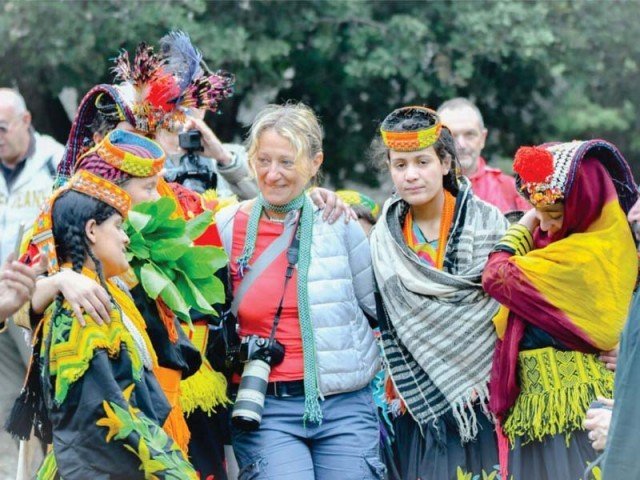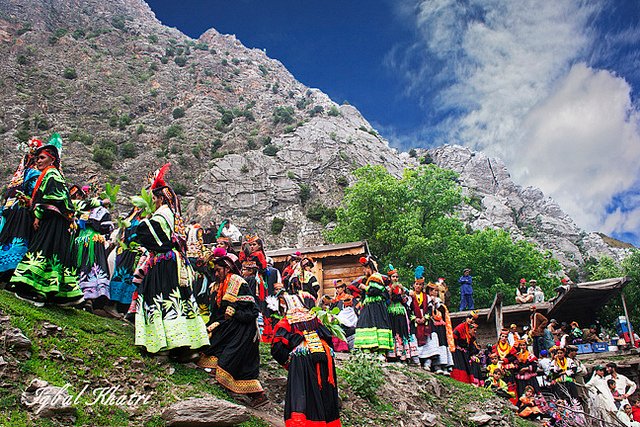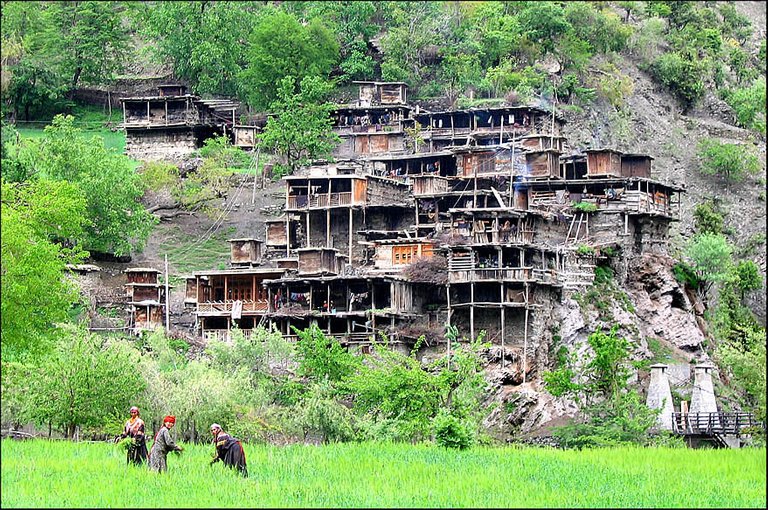A Brief History of the Kalash :
The Kalash are the last surviving animists in Central Asia. They live in three valleys, high up in the Hindu Kush mountains on the border with Afghanistan.

The Kalash creed is all that remains of a faith, which was once followed across the Hindu Kush. The territory of these animists was known as Kafiristan or ‘Unbeliever country’. Over the past few centuries Kafiristan shrunk into two distinct zones: the area occupied by the Black Kaffirs who are the present day Kalash and the area occupied by the Red Kaffirs, the descendants of whom live the Afghan province of Nuristan. In 1895-6 a jihad lead by the Emir of Kabul forcibly converted the Red Kaffirs. The territories of the Black Kaffirs however, were out-with the Emir's juristrisction and therefore escaped the Emir’s jihad.

The Kalash religion is especially significant because it is probably a survivor, along with Zoroastrianism and Hinduism, of a very ancient Indo European faith. Although the Kalash are often referred to as 'polytheist', most Kalash claim that they are monotheist, worshiping one creator god, 'desau' and that the other figures in the Kalash pantheon are not gods but Desau's messengers . The Kalash faith can also be described as animist since the Kalash believe that trees, stones and streams all have souls.

The Kalash religious calendar is split into Spring, Autumn and Winter festivals. Interestingly these seasonal festivals mirror the old pagan festivals of Europe. The festivals involve sacrifices, the baking of special bread, feasts, dances and songs. During these festivals the concept of purity is given special importance. Everything must be purified: people, homes, even whole villages. Purification is achieved by a combination of cleaning, incantation and encirclement with a wand of burning juniper.

The practice of the Kalash religion/culture has changed with outside influence through the twentieth century. After the creation of Pakistan the situation of the Kalash became precarious, however in the 1970s the government of Zulfikar Ali Bhutto made moves to ensure the protection of the Kalash.
Today there are about 3,000 Kalash. Although every year some Kalash are converted to Islam their numbers remain stable as they have an increasingly low child mortality rate. The Kalash are also protected by the Pakistani constitution although the Ministry of Minority Affairs whose specific duty it was to support Pakistan's religious minorities as recently been disbanded.
Chaumos, A Kalash Festival :
Chaumos is the most important Kalash festival -the others being in spring and autumn- and is celebrated for two weeks at winter solstice (c. Dec. 7-22). The festival marks the end of the year's work in the fields. It involves song, dancing, and the sacrifice of goats. It is dedicated to the god Balaumain who is believed to visit from the mythical homeland of the Kalash, Tsyam, for the duration of the feast (When I visited there were two small earthquakes; one at the beginning and the other at the end of the festival, these were attributed to the arrival and departure of Balaumain). Food sacrifices are offered at the clans' Jeshtak shrines which are, in part dedicated to ancestors. Other ceremonies include the baking of a special sort of walnut bread from pure ingredients and the manufacture of small dough animals along with a shepherd to protect them. Purification also plays and important role in Chamous and the whole population, their homes and the villages they live in are purified by a mixture of encirclement with wands of burning juniper and ritual washing.
Kalash man drawing an ibex on the wall of the village han or temple. The han is the focus of the majority of Chaumos' ritual activities. One of the most important of these activities is the 'decoration' of the han with images, especially depictions of herbivores. The medium used is a dark paste, the main ingredient of which is burnt walnut bark. Since walnuts are of particular import during Chaumos its likely that the choice of walnut bark pigment adds some special spiritual significance to the images. The image being drawn in the film is an ibex. The highly stylized representation of an ibex in the film is consistent with rock art found in areas which were once kaffir, but are now Muslim, suggesting that it is an ancient formula.
dough shepherd and his flock mentioned above. Dough containing ground walnuts is used to make the figures, as with the han drawings the inclusion of walnut lends the figures a special spiritual significance. Once moulded the figures are left beside the fire to harden and then baked within the fire. The baked shepherd and his flock are finally set up in the home, the flock closely packed together and the shepherd herding them from behind as in real life.
The festival does succeed in creating a sense of pride around the valley in the unique atmosphere of liberation and relaxation. Boys and girls openly spend carefree time together, joking and laughing.
The festival does succeed in creating a sense of pride around the valley in the unique atmosphere of liberation and relaxation. Boys and girls openly spend carefree time together, joking and laughing.
But many people reminded me that some traditions had already disappeared. And one Kalash resident, Luke Rehmat, sounded a further note of warning.
"The younger generation is not into the traditions," Mr Rehmat said. "They don't want to learn songs and take part."



Hi! I am a robot. I just upvoted you! I found similar content that readers might be interested in:
http://www.kalashwelfare.org/index.php?/about-kalash/history-and-culture-of-the-kalash/